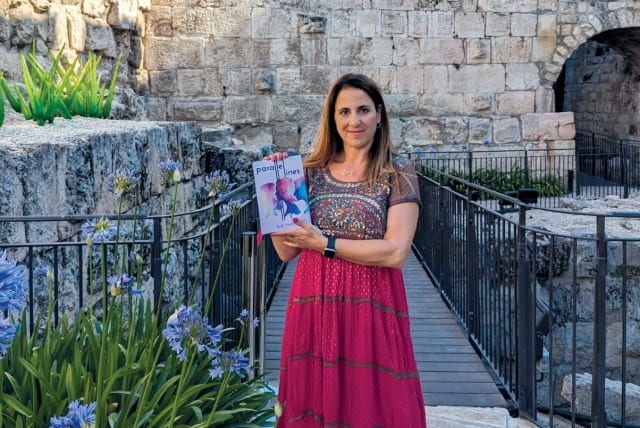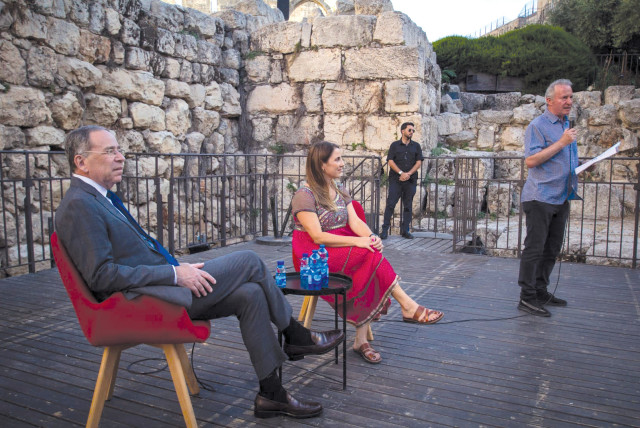'Parallel Lines': YA novel portrays Jerusalem's complex reality - review

The title “Parallel Lines” refers to the route of the light rail, which traverses through both Jewish and Palestinian neighborhoods, and to the lives of the three main characters.
I started reading the new novel by Ruth Marks Eglash on a long Shabbat when I had plenty of time to read. And once I started Parallel Lines, I couldn’t put it down. I was completely wrapped up in all three of the 16-year-old female characters: Tamar, Nour, and Rivki.
Tamar is a secular Jewish teenager based, Eglash told The Jerusalem Report, on her own daughter Gefen. Nour is a young Palestinian fashionista, a compilation of young women that Eglash encountered during her reporting for The Washington Post. And Rivki, the young haredi woman questioning her background, is based on Eglash’s haredi hairdresser.
But the real star of the show in Parallel Lines is Jerusalem – that complex, infuriating, challenging, beautiful, and crazy city that many of us call home. The title “Parallel Lines” refers to the route of the light rail, which traverses through both Jewish and Palestinian neighborhoods, and to the lives of the three main characters.
“It’s nice for me that people who live in Jerusalem read it and know all of the places I mention,” Eglash told the Report. “But I really want it to be read abroad, either by people who know nothing about the conflict or by people who think they know about the conflict but don’t really know.”
Eglash held a book launch at the Tower of David Museum, where she was interviewed by Tom Nides in his last public appearance as US ambassador to Israel. Eglash said that fiction enabled her to avoid many of the restrictions of journalism and depict Jerusalem the way she sees it.
“I wanted people to understand what it is to live in this crazy city that is always under scrutiny,” she said.
Telling the story of Jerusalem in fiction
Eglash vividly describes the light rail train, one of the places in Jerusalem where Jews and Arabs interact:
Elbows were sharper and bad manners were not restricted to any one of this holy city’s specific tribes. All souls, regardless of their religion, culture, gender or age, jostled their way inside the light rail’s narrow carriages, and everyone was in a rush. Early risers heading to catch the first deals in the shuk, empty shopping trolleys in tow, went head-to-head with round-bellied and bearded men in black Borsalino hats. Scruffy laborers in faded blue jeans and tired T-shirts, who would spend their day mixing cement and laying bricks, took up aces next to those smartly dressed in slacks or skirts topped with button-down shirts heading to the offices and stores that filled the city center. Backpackers, tourists, and schoolchildren, like her, crowded into an already cramped space.
At the beginning of the book, both Tamar and Nour suffer acts of violence – one sexual and the other nationalistic. Tamar does not know if her attacker is Arab, although one of her friends at school is convinced he is. Nour, the young Palestinian woman, is saved by a pair of Israeli soldiers in the Old City of Jerusalem, one of whom is a young woman just a little older than she is.
She’s seen female soldiers before. Sometimes they were even more heartless than the men, but this one seemed different. Her eyes were a soft brown, her skin a dark olive, much darker than Nour’s own…. Nour supposed Israeli soldiers were allowed to be pretty, but it didn’t excuse the ugliness of their behavior.
Eglash does a great job describing the complexity of Palestinian life in east Jerusalem. The third character, Rivki, is from a haredi community but is trying to learn more about broader Israeli society. She gets a chance on frequent visits to Israeli hospitals for treatment for her Crohn’s disease.
She wondered if she wasn’t already corrupted with bad thoughts creeping into her head like tiptoeing shadows. It wasn’t just about milling around the center of the city or even ripping off her clothes on hot, sweltering days. On these hospital days, she also imagined what it would be like to try on a pair of jeans, her knobby knees poking through rugged tears, or to wear a sweet summer dress that would allow the air to kiss her bare legs. Then she worried G-d would punish her for thinking this way. Maybe He already had. Maybe that was why she got sick.
I won’t write any more about the plot to avoid spoilers, but as the well-written story gathers steam, it makes you want to keep turning the pages. Eglash said that her book is categorized in the Young Adult genre because all the protagonists are 16. She said that someone suggested she make them 18 to escape the label “Young Adult.”
“But then Tamar would be in the army, Nour would probably be in university, and Rivki might even be married,” Eglash said with a laugh. So she was forced to remain in the Young Adult genre, but the book deals with adult subjects, which makes it basically “a crossover,” she said.
“But making the book ‘Young Adult’ makes me happy,” she added. “I think young people are reading books more than we think, and I think the book is a good introduction to the conflict and what’s happening. I want people to get a sense of what life here is really like.”
It is also a very personal book for Eglash. She said that her daughter Gefen studied at the Nisui high school in the center of downtown Jerusalem and was there during the lone-wolf Palestinian stabbing attacks of 2015-2016.
“The school is a Montessori-type school, and the children are very engaged and curious about what is happening,” she said. “They also had a lot of political discussions in the school, and there was an Arab boy in her class, just like in the book.”
Eglash said she is especially pleased when she receives messages from people who have read the book and had no prior exposure to the Israeli-Palestinan conflict. One reader from Luxembourg contacted her; and after a chat about “Jewish geography,” it became evident that he was distantly related to her husband, Michael, so she has found a new relative.
And that, ultimately, is the message of Parallel Lines: Somehow, we are all tied to one another. At the end of the book, after a dramatic event about which you’ll have to read for yourself, all three young women are invited to the President’s Residence in Jerusalem to receive a special award.
“Rivki, Nour and Tamar,” the president addressed them with kind eyes. “You have proven that the superficial disguises of your communities are inconsequential, that cooperation can bridge all divides, and that Jerusalem’s tribes can find a way to work together. I now name you all as the first members of a Jerusalem tribe. One that is not defined by a single group, one that does not exclude anyone. It is a tribe that belongs to everyone and is for everyone. It is all-inclusive. It is the tribe of humanity.”
Eglash’s book should help more of us join that new Jerusalem tribe – the tribe of humanity. ■
Parallel LinesRuth Marks EglashBlack Rose Writing, 2023304 pages, $20.66
Jerusalem Post Store
`; document.getElementById("linkPremium").innerHTML = cont; var divWithLink = document.getElementById("premium-link"); if (divWithLink !== null && divWithLink !== 'undefined') { divWithLink.style.border = "solid 1px #cb0f3e"; divWithLink.style.textAlign = "center"; divWithLink.style.marginBottom = "15px"; divWithLink.style.marginTop = "15px"; divWithLink.style.width = "100%"; divWithLink.style.backgroundColor = "#122952"; divWithLink.style.color = "#ffffff"; divWithLink.style.lineHeight = "1.5"; } } (function (v, i) { });

